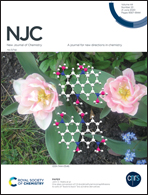Remarkable second and third order nonlinear optical properties of organometallic C6Li6–M3O electrides
Abstract
Electrides are excess electron compounds with excellent nonlinear optical properties. Herein we report the geometric, electronic, and nonlinear optical properties of C6Li6–M3O electrides. These electrides are designed by doping superalkalis (Li3O, Na3O, and K3O) on hexalithiobenzene (C6Li6). Density functional theory results reveal that charge transfer occurs from M3O to hexalithiobenzene (C6Li6). Ab initio molecular dynamics (AIMD) simulations at room temperature reveal that these complexes are quite stable thermodynamically. These electrides possess lower HOMO–LUMO energy gaps and crucial excitation energies than pristine C6Li6. The NLO response of the designed electrides is studied through first hyperpolarizability (βtot), second hyperpolarizability (γtot), frequency-dependent second harmonic generation (SHG), the electro-optic Pockels effect (EOPE), electric field-induced second harmonic generation (ESHG), the electro-optic Kerr effect (EOKO), hyper-Rayleigh scattering coefficient (βHRS) and nonlinear refractive index (n2). A remarkably high frequency induced dc-Kerr effect (up to 3.0 × 1016 a.u.) and ESHG (up to 2.2 × 1015 a.u.) are computed for the designed electrides. Moreover, these electrides also exhibit an enormously high quadratic nonlinear refractive index (up to 2.6 × 10−6 a.u.). This work provides new insights for designing stable organometallic electrides (C6Li6–M3O) with enhanced NLO response.



 Please wait while we load your content...
Please wait while we load your content...